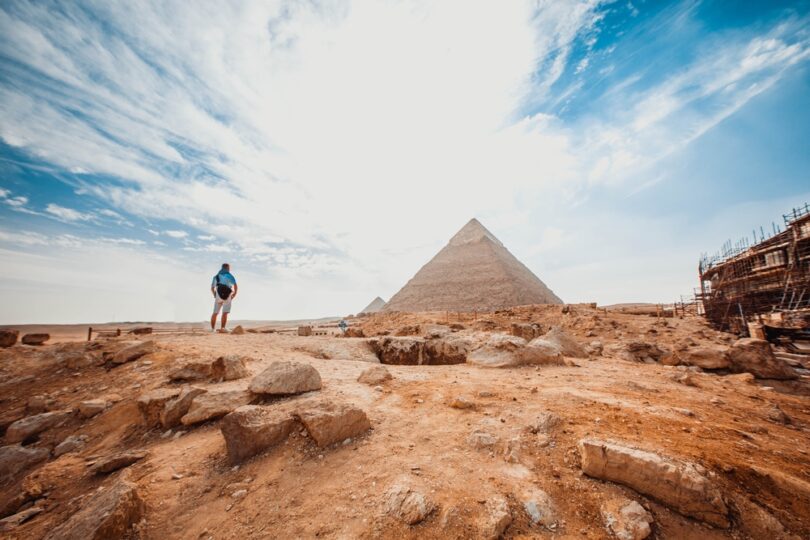For centuries, Egypt has fascinated travelers with its long history, towering pyramids, and stories of ancient civilizations. Home to legendary Pharaohs, intricate hieroglyphs, and awe-inspiring monuments, the Land of the Nile offers an unparalleled glimpse into the past. While political events have occasionally affected tourism, Egypt has consistently proven its resilience, welcoming visitors from around the world to explore its wonders.
Today, Cairo remains a captivating destination, where ancient history and modern culture collide. With ongoing efforts to enhance security, restore historic sites, and improve visitor experiences, there’s never been a better time to visit. Whether you’re exploring the iconic Pyramids of Giza, wandering through bustling markets, or marveling at newly unveiled archaeological discoveries, Cairo continues to offer an unforgettable journey through time.
Is it Safe to Travel to Cairo?
 Safety is a common concern for travelers visiting any major destination, and Cairo is no exception. While certain regions of Egypt are not advisable for tourists, popular areas like Cairo, Giza, Luxor, and Aswan remain well-patrolled and welcoming to visitors.
Safety is a common concern for travelers visiting any major destination, and Cairo is no exception. While certain regions of Egypt are not advisable for tourists, popular areas like Cairo, Giza, Luxor, and Aswan remain well-patrolled and welcoming to visitors.
Egyptian authorities have implemented extensive security measures in recent years, particularly in areas frequented by tourists. Airports, hotels, and major attractions have heightened security protocols, and there is a strong military and police presence throughout the country. As with any destination, it’s important to stay informed, follow travel advisories, and take basic precautions to ensure a smooth and enjoyable trip.
While some parts of Egypt require extra caution, including the Sinai Peninsula (except for Sharm El-Sheikh), the Western Desert, and border areas, Cairo itself remains a vibrant and well-guarded city. Millions of visitors safely explore its ancient sites, markets, and museums each year, making it a rewarding destination for those eager to experience the wonders of Egyptian history and culture.
How to Travel Safely in Cairo
 Cairo is a lively and bustling city, and as with any major travel destination, taking a few precautions can help ensure a safe and enjoyable visit. Here are some key tips to keep in mind:
Cairo is a lively and bustling city, and as with any major travel destination, taking a few precautions can help ensure a safe and enjoyable visit. Here are some key tips to keep in mind:
- Stay Aware of Your Surroundings – Be mindful in crowded places such as markets, public transportation, and popular tourist sites, where petty theft and pickpocketing can occur.
- Avoid Large Gatherings and Protests – Political demonstrations can happen unexpectedly. It’s best to steer clear of large crowds and stay updated on local news and travel advisories.
- Use Reliable Transportation – Stick to licensed taxis, ride-hailing apps, or reputable tour operators when getting around the city. Public transportation can be overwhelming for first-time visitors.
- Respect Local Customs and Dress Modestly – Egypt is a predominantly Muslim country with conservative cultural norms. While there is no strict dress code, women may feel more comfortable covering their shoulders and knees, especially when visiting religious sites. Carrying a scarf for such occasions is a good idea.
- Consider Traveling with a Guide or Group – Guided tours not only enhance your experience but can also provide added security, especially when navigating historical sites or less familiar areas.
- Secure Your Belongings – Keep valuables like passports, credit cards, and extra cash in a hotel safe. Use a crossbody bag or money belt to keep essentials secure when exploring the city.
- Register with Your Embassy – Many governments offer programs like the U.S. State Department’s Smart Traveler Enrollment Program (STEP), which allows travelers to receive safety updates and assistance in case of an emergency.
By taking these precautions, visitors can confidently explore Cairo’s vibrant streets, world-renowned museums, and breathtaking ancient landmarks while enjoying a safe and enriching experience.
You Might Also Enjoy: Cairo Travel Brief: What to Know Before You Go
FAQs:
Q: What is the best time of year to visit Cairo?
A: The best time to visit Cairo is from October to April when temperatures are cooler and more comfortable for sightseeing. The winter months (December–February) offer pleasant weather, while spring and fall provide fewer crowds.
Q: Do I need a visa to visit Egypt?
A: Most travelers need a visa to enter Egypt. Many nationalities can obtain a visa on arrival or apply online for an e-visa. Check with the Egyptian consulate for specific requirements based on your country of residence.
Q: What currency is used in Cairo, and can I use credit cards?
A: The local currency is the Egyptian Pound (EGP). While major hotels and restaurants accept credit cards, cash is preferred in markets, small shops, and taxis. ATMs are widely available for withdrawals.
Q: Is tap water safe to drink in Cairo?
A: It’s not recommended to drink tap water in Cairo. Stick to bottled water, which is inexpensive and widely available. Avoid ice cubes in drinks if you’re unsure of the water source.
Q: What is the best way to get around Cairo?
A: Cairo’s metro system is affordable and efficient for short distances. Ride-hailing apps like Uber and Careem are reliable options, while taxis should be used with agreed-upon fares. Walking is best reserved for certain areas due to traffic congestion.
Q: What language is spoken in Cairo?
A: Arabic is the official language, but many people working in tourism speak English. Learning a few basic Arabic phrases can be helpful for communication with locals.
Q: What should I pack for a trip to Cairo?
A: Lightweight, breathable clothing is best, along with comfortable walking shoes. Bring a scarf or shawl for visiting religious sites, sunscreen, sunglasses, and a refillable water bottle. Modest attire is recommended for cultural respect.
Do you have any trips for traveling safely? Tell us about them in the comments below!








